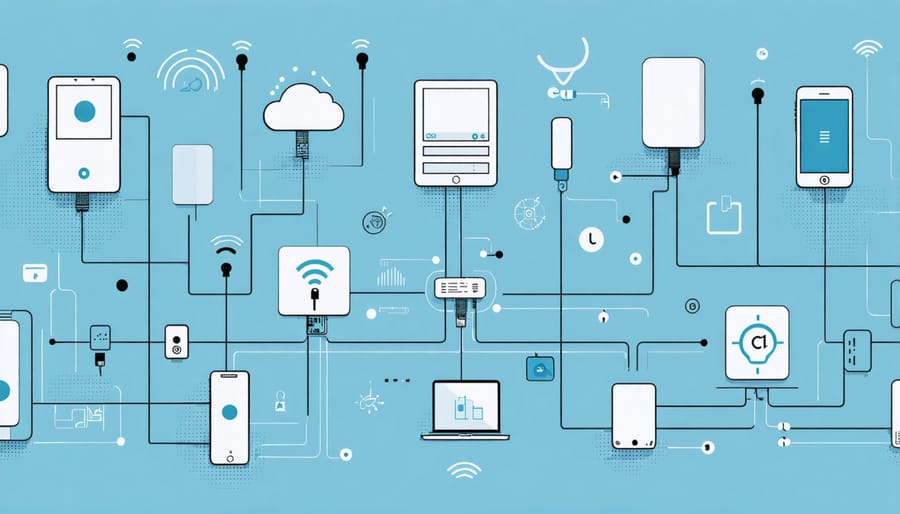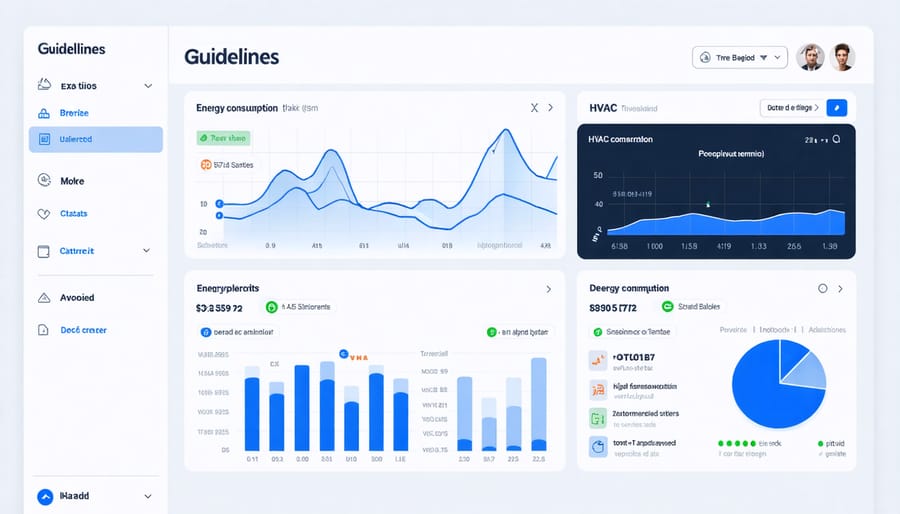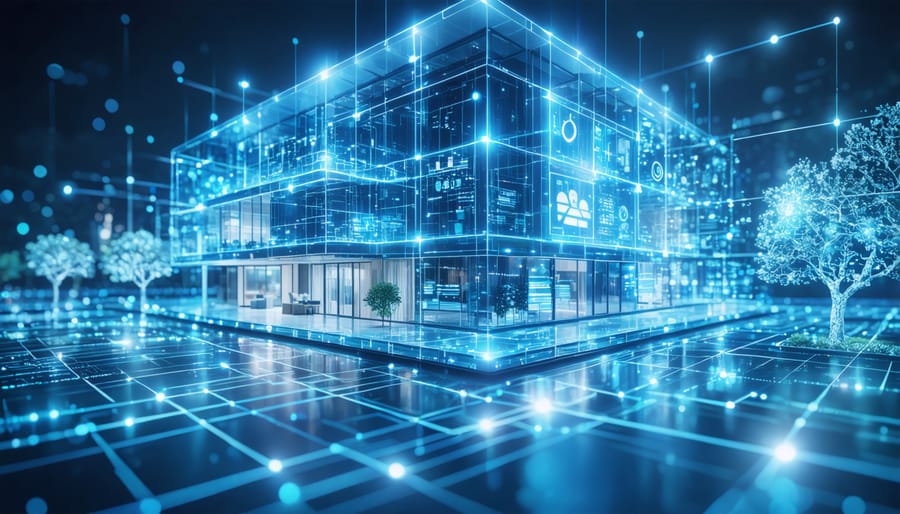Transform modern buildings into intelligent ecosystems by integrating IoT infrastructure from the ground up. AI-powered building management systems now deliver unprecedented control over energy consumption, occupant comfort, and operational efficiency, reducing facility costs by up to 30% annually.
Strategic sensor placement throughout the building envelope captures real-time data on temperature, occupancy, and resource usage, enabling automated responses to changing conditions. This network of interconnected devices forms the backbone of a smart building ecosystem, where every system from HVAC to lighting operates in perfect synchronization.
Construction professionals implementing IoT solutions must prioritize scalable architecture that accommodates future technological advances while maintaining robust cybersecurity protocols. The investment in smart building infrastructure typically generates returns within 24-36 months through reduced operational costs, enhanced tenant satisfaction, and increased property values.
By integrating IoT technology during the construction phase rather than retrofitting, buildings become inherently intelligent, positioning them at the forefront of the digital transformation revolutionizing commercial real estate.
The Architecture of Modern Building IoT Systems

Core Components and Sensors
The foundation of any IoT building system lies in its core components and sensing technologies. These essential elements work together to create a comprehensive monitoring and control network throughout the building infrastructure.
At the heart of IoT implementations are microcontrollers and single-board computers, such as Arduino and Raspberry Pi, which serve as the primary processing units. These controllers interface with various sensors that collect crucial environmental and operational data.
Temperature and humidity sensors form the backbone of environmental monitoring, enabling precise climate control and energy optimization. Occupancy sensors, including PIR (Passive Infrared) and ultrasonic detectors, track space utilization and automate lighting systems. Advanced CO2 sensors monitor air quality, while pressure sensors detect water leaks and maintain optimal HVAC performance.
Energy monitoring components, such as smart meters and current transformers, provide real-time power consumption data. Light level sensors facilitate adaptive lighting control, while motion sensors enhance security systems and automate access control.
Network connectivity is achieved through communication modules utilizing protocols like Wi-Fi, Bluetooth, LoRaWAN, or Zigbee, depending on range and power requirements. Gateway devices aggregate sensor data and facilitate secure transmission to cloud platforms or local servers.
For structural health monitoring, vibration sensors and strain gauges track building integrity, while smart actuators enable automated responses to sensor inputs, adjusting building systems in real-time for optimal performance and efficiency.
Network Infrastructure Requirements
A robust network infrastructure forms the backbone of any successful IoT implementation in modern buildings. The architecture typically consists of three primary layers: the physical network layer, the data transport layer, and the network management layer. Each plays a crucial role in ensuring seamless communication between devices and systems.
For the physical layer, a combination of wired and wireless solutions is recommended. Ethernet connections provide reliable, high-speed data transmission for stationary equipment, while Wi-Fi networks support mobile devices and sensors. In larger buildings, mesh networks can extend coverage and ensure consistent connectivity throughout the structure.
The data transport layer must support various protocols commonly used in building automation, including BACnet, Modbus, and MQTT. Implementation of a gateway system helps integrate these different protocols, enabling smooth communication between diverse IoT devices and building management systems.
Network security is paramount, requiring the implementation of VLANs to segregate building systems from other network traffic. Advanced encryption protocols, firewalls, and regular security audits help protect sensitive building data from cyber threats.
Scalability considerations are essential when designing the network infrastructure. The system should accommodate future expansion and increased device density without compromising performance. Redundant connections and failover systems ensure continuous operation of critical building functions, while Quality of Service (QoS) configurations prioritize essential traffic during peak loads.
Real-Time Resource Management Applications
Energy Consumption Optimization
Energy consumption optimization in IoT-enabled buildings represents a significant advancement in sustainable construction and facility management. Through the implementation of smart energy management solutions, buildings can achieve substantial reductions in energy usage while maintaining optimal comfort levels for occupants.
Modern IoT systems employ a network of sensors and actuators to monitor and control various building systems in real-time. These sensors collect comprehensive data on temperature, occupancy, lighting levels, and equipment performance, enabling facility managers to make data-driven decisions. By analyzing smart building metrics, managers can identify inefficiencies and implement automated responses to optimize energy consumption.
Key components of an energy optimization system typically include:
– Smart HVAC controls that adjust based on occupancy patterns
– Automated lighting systems with daylight harvesting capabilities
– Power monitoring systems for equipment and appliances
– Predictive maintenance algorithms to ensure optimal system performance
Implementation success relies on proper system integration and careful consideration of building-specific requirements. Case studies have shown that buildings utilizing IoT-based energy management systems can achieve energy savings of 20-30% compared to conventional buildings. These systems also contribute to enhanced operational efficiency and reduced maintenance costs, making them an essential component of modern building management strategies.

Water Usage Monitoring
Water usage monitoring through IoT implementation has become a cornerstone of efficient building management, with modern water management systems offering unprecedented control and insight into consumption patterns. Advanced sensors strategically placed throughout the building’s water infrastructure provide real-time data on usage, pressure variations, and potential anomalies.
These systems typically incorporate ultrasonic flow meters, pressure sensors, and smart valves that communicate through a centralized IoT platform. The technology enables facility managers to detect leaks instantly, with some systems capable of identifying issues down to specific pipeline sections. Implementation of these solutions has shown reduction in water waste by up to 30% in commercial buildings.
Key features include automated shut-off capabilities that activate when unusual flow patterns are detected, preventing costly water damage. Machine learning algorithms analyze historical usage data to establish baseline consumption patterns and flag deviations that might indicate problems. This predictive maintenance approach has proven particularly valuable in large-scale commercial developments where traditional manual monitoring would be impractical.
Building managers can access detailed analytics through dashboard interfaces, allowing them to optimize water usage schedules, implement conservation measures, and demonstrate compliance with environmental regulations. Integration with building management systems (BMS) ensures coordinated resource management across all building systems.
HVAC System Integration
HVAC systems integrated with IoT technology represent a significant advancement in building management, offering unprecedented control over indoor climate conditions while optimizing energy consumption. Smart sensors deployed throughout the building continuously monitor temperature, humidity, CO2 levels, and occupancy patterns, enabling real-time adjustments to maintain optimal comfort levels.
The integration enables predictive maintenance capabilities through machine learning algorithms that analyze performance data. These systems can detect potential equipment failures before they occur, reducing downtime and maintenance costs. For instance, sensors can identify patterns in equipment behavior that indicate wearing components or efficiency decline, allowing facility managers to schedule maintenance proactively.
Advanced HVAC IoT solutions also facilitate zone-based climate control, automatically adjusting settings based on occupancy and usage patterns. During peak hours, the system can pre-cool or pre-heat spaces before occupants arrive, while automatically reducing output in vacant areas. This intelligent automation typically results in energy savings of 20-30% compared to traditional HVAC systems.
Real-time analytics dashboards provide facility managers with comprehensive insights into system performance, energy consumption, and environmental conditions. These platforms enable data-driven decisions about system operations and maintenance schedules, while automated alerts ensure immediate response to any anomalies or performance issues.
Integration with other building systems, such as lighting and security, creates a cohesive ecosystem that maximizes efficiency and occupant comfort while minimizing operational costs.

Implementation Case Study: Manchester Commercial Tower
The Manchester Commercial Tower stands as a prime example of successful IoT implementation in modern commercial architecture. Completed in 2021, this 45-story building incorporates over 12,000 IoT sensors and devices, creating a fully connected ecosystem that has reduced operational costs by 32% within its first year of operation.
The building’s IoT infrastructure centers around a unified building management system that integrates HVAC, lighting, security, and occupancy monitoring. Smart sensors throughout the facility collect real-time data on temperature, humidity, CO2 levels, and occupancy patterns. This information feeds into a central analytics platform that continuously optimizes building operations.
One of the most innovative features is the predictive maintenance system for elevators and HVAC equipment. Using machine learning algorithms, the system analyzes performance data to identify potential issues before they cause disruptions. This approach has reduced unexpected maintenance incidents by 78% and extended equipment lifespan by an estimated 25%.
The occupancy monitoring system has proved particularly valuable for energy management. Motion sensors and smart meters work in tandem to adjust lighting and temperature controls based on real-time usage patterns. Conference rooms automatically power down when vacant, while common areas adapt to varying occupancy levels throughout the day.
Security integration has been another success story, with IoT-enabled access control systems processing over 5,000 entries daily. Biometric scanners and smart cards communicate with a central security hub, while AI-powered surveillance cameras provide intelligent threat detection.
The building’s energy consumption is monitored and optimized through a network of smart meters and sub-meters. Solar panels on the roof connect to an intelligent grid system that automatically adjusts power distribution based on demand and availability. This smart energy management has resulted in a 45% reduction in energy costs compared to similar-sized conventional buildings.
Tenant satisfaction has increased significantly, with 94% reporting improved comfort levels and workspace functionality. The building’s mobile app allows occupants to customize their immediate environment, book facilities, and report issues directly through their smartphones.
The success of the Manchester Commercial Tower demonstrates how strategic IoT implementation can transform building operations, enhance user experience, and deliver substantial cost savings while promoting sustainability.
Integration Challenges and Solutions
While IoT implementation in buildings offers tremendous potential, several common challenges need to be addressed for successful deployment. Network infrastructure limitations often present the first hurdle, particularly in older buildings where existing wiring may not support modern IoT requirements. To overcome this, organizations frequently implement hybrid networking solutions, combining wireless technologies with strategic cable upgrades in critical areas.
Security concerns represent another significant challenge, as interconnected building systems create multiple potential entry points for cyber threats. Implementation of robust security protocols, including end-to-end encryption, regular security audits, and segmented networks, helps mitigate these risks. Additionally, working with certified IoT security specialists during the planning phase can ensure comprehensive protection measures are in place.
Device compatibility and interoperability issues frequently arise when integrating various IoT systems from different manufacturers. This challenge can be addressed by adopting open standards and protocols, ensuring all components can communicate effectively. Many organizations are now requiring vendors to demonstrate interoperability before procurement, reducing integration headaches later.
Data management presents another crucial challenge, as IoT systems generate massive amounts of information that must be stored, processed, and analyzed effectively. Cloud-based solutions with edge computing capabilities offer a scalable approach to handling this data volume while maintaining system responsiveness. Implementing clear data governance policies helps ensure information is properly managed throughout its lifecycle.
Cost considerations often impact IoT implementation scope. A phased approach, starting with high-impact areas and gradually expanding based on demonstrated ROI, helps manage initial investments while proving system value. Organizations can also explore vendor partnerships and financing options to distribute costs over time.
Addressing these challenges requires careful planning and a strategic approach. Success often depends on establishing clear objectives, selecting appropriate technology partners, and maintaining flexibility to adapt as implementation progresses. Regular stakeholder communication and continuous monitoring of system performance help ensure challenges are identified and addressed promptly.
The integration of IoT technology in building resource management represents a transformative shift in how we operate and maintain modern facilities. By leveraging interconnected sensors, automated systems, and data analytics, organizations can achieve significant reductions in energy consumption, operational costs, and environmental impact. Industry trends indicate that IoT implementations will continue to evolve, incorporating artificial intelligence and machine learning to deliver even more sophisticated predictive maintenance capabilities and resource optimization strategies.
Looking ahead, the construction industry can expect to see increased adoption of IoT solutions, driven by improving ROI metrics and declining implementation costs. As smart building technologies mature, we anticipate more seamless integration between different systems and enhanced cybersecurity measures to protect critical infrastructure. For construction professionals and facility managers, embracing IoT technology is no longer optional but essential for maintaining competitive advantage and meeting increasingly stringent sustainability requirements in the built environment.

